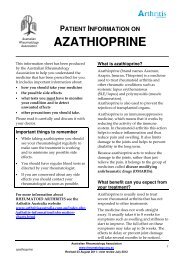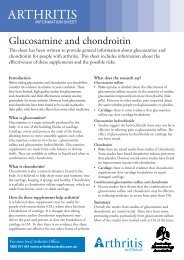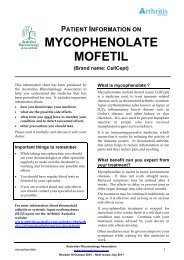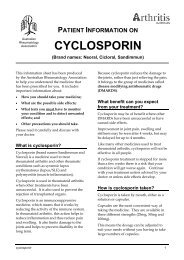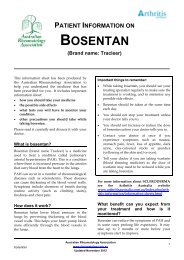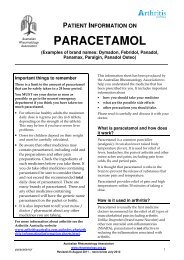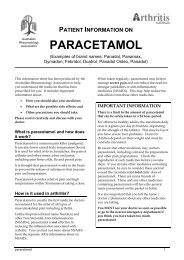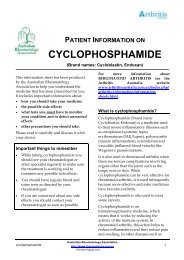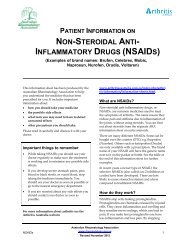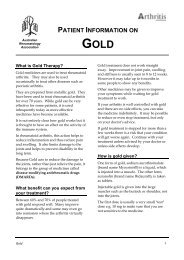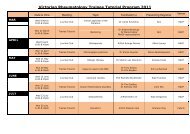scleroderma connections patient news issue 4 - Australian ...
scleroderma connections patient news issue 4 - Australian ...
scleroderma connections patient news issue 4 - Australian ...
You also want an ePaper? Increase the reach of your titles
YUMPU automatically turns print PDFs into web optimized ePapers that Google loves.
WELCOMESusanna ProudmanDONATIONSASIG Research ProgramPROFILERoyal Adelaide HospitalPAH EXPLAINEDby Leah McWilliamsResearchASIG Research OutputSclerodermaEdition 4: NOVEMBER 2011 PATIENT NEWS
donations.ASIG ResearchProgramgreetings,The original motivation for establishing the <strong>Australian</strong>Scleroderma Screening Program was to provide a serviceto people with <strong>scleroderma</strong> and their doctors, for screeningfor the serious complication of pulmonary arterialhypertension (PAH).Thank you to the families and friendsof the late Mrs Rebecca Haddockand Mrs Brenda Matear for theirgenerous donations to the researchfund. Donations assist a number ofour projects such as blood sampleresearch, maintenance of thenational database and funding of aPhD student.Anyone wishing to make a donationto the fund should contact theProject Co-ordinator, Jill Byron onjill.byron@svhm.org.au or phone(03) 9288 3986.But why all the fuss about PAH?Timely identification of PAH can be complex,particularly in a busy rheumatology practice.The “one stop shop” visit to a screeningcentre for tests and clinical assessment aimsto take the worry out of this process. Whilean elevated pulmonary arterial pressure onan echocardiogram is a strong predictor ofPAH, this often occurs late in the disease,so detection relies on a combination ofother factors including reduced diffusingcapacity on lung function tests and reducedexercise tolerance. Unfortunately, peoplewith <strong>scleroderma</strong> can have a poor exercisecapacity for so many reasons, makingit difficult to unravel the cause of theirsymptoms. The primary goal of the screeningprogram is to increase rates of detection ofPAH in its early stages. In addition, the spinoff<strong>Australian</strong> Scleroderma Cohort study isdriving multiple research studies, some ofwhich aim to find better markers of PAH inits early stages and which are summarisedelsewhere in this <strong>news</strong>letter.These are worthy objectives indeed, but inall the complexities of screening tests anddata collection, we must not lose sight ofthe individual caught in the vortex of all thisactivity, who is being poked and prodded,while all the while hoping that a right heartcatheter (required for diagnosis of PAH) isnever recommended and if it is, that PAH isnever detected. Undoubtedly, this can be aserious and debilitating complication and asource of much anxiety but it is not all bad<strong>news</strong>. De-mystifying some of the <strong>issue</strong>s aroundPAH is one of the important components ofmanaging this disease.Firstly, 90% of <strong>patient</strong>s with <strong>scleroderma</strong> willnever develop PAH. It is only because betternon-invasive methods for early detectionare yet to be developed, that internationalguidelines currently recommend annualscreening. Newer therapies have measurablebenefits in this condition. Furthermore, itappears likely that earlier detection andtreatment leads to improved survival sothere is much to be optimistic about. Whilethere has been a growing and rewardingcollegiality between the various specialistswho treat this disease – cardiologists,respiratory physicians and rheumatologists –the “glue” which holds the PAH clinic togetheris the PAH nurse. In the <strong>patient</strong> version of this<strong>issue</strong>, Leah McWilliams, PAH nurse at theRoyal Adelaide Hospital, the centre featuredin this <strong>issue</strong>, provides helpful advice for thenew <strong>patient</strong> with PAH. The clinical supportand pastoral care provided to people withPAH and <strong>scleroderma</strong> by these dedicatedPAH nurses is without doubt, second to none.Susanna ProudmanASIG ChairWorldSclerodermaDayThis day occurs in June. It is agood opportunity to educatehealth professionals and the widercommunity about <strong>scleroderma</strong>.This year, at St Vincent’s Hospitalthe <strong>scleroderma</strong> team held aninformation session for staff acrossthe hospital. Presentations weregiven by Dr Wendy Stevens andBarbara Gemmell focusing on theclinical aspects of <strong>patient</strong> care, andthe fellows Dr Vivek Thakkar and DrOwen Moore gave an overview oftheir research projects. It was wellattended and included nurses fromthe wards and from in-home care,technicians from the respiratory clinicand others interested in learningabout the disease.The lunch sponsored by Actelion wasmuch appreciated.
profile.A/Prof Susanna Proudman and Leah McWilliamsRoyal AdelaideHospitalLeah McWilliams began training as anurse at the Royal Adelaide Hospital in1987. She writes, “On completing mytraining, I secured a permanent positionas a registered nurse in an orthopaedic/rheumatology ward and soon became aclinical nurse. Travel beckoned, resultingin twelve months of backpacking inAmerica, Europe and South Africa.On returning to Adelaide, I completeda Bachelor of Nursing degree atFlinders University and found myselfback at the RAH in the Orthopaedic/Rheumatology Out<strong>patient</strong> department.It was here I was approached by A/Prof Susanna Proudman to take up theposition as clinical studies manager forthe Rheumatology Unit.I embarked upon a very steep learningcurve, managing a clinical trial in<strong>patient</strong>s with early rheumatoid arthritisand another in pulmonary arterialhypertension. I was also enlisted by thecardiology and respiratory physiciansto assist with Medicare applicationsfor highly specialised drugs for PAH.The staff weren’t quite sure what arheumatology nurse was doing in theirOPD, but were welcoming, interestedand accommodating.The <strong>scleroderma</strong> screening programgrew fast and we now have over155<strong>patient</strong>s enrolled, so my feet didn’t reallyhit the ground till a new cardiac nursecame on board early this year.My main role is to be a first point ofcontact for <strong>patient</strong>s, answer questions,provide educational support, liaisewith pharmacists, GP’s, specialistphysicians, community nurses andresearch staff. I prepare and collate<strong>patient</strong> files to help streamline <strong>patient</strong>visits, perform joint examinations andcomplete lots of paperwork! I providesupport to the clerical staff by makingsure appointments are as convenientas possible for <strong>patient</strong>s. Often I catchup with <strong>patient</strong>s admitted to the wards,but the aim is to provide enough‘accessible’ support to keep admissionsto a minimum.It is A/Prof Susanna Proudman’severyday example that is a privilege tobe near and the quiet bravery of our<strong>patient</strong>s that makes working at the RAHso extraordinary.A career highlight was receiving a‘Commendation award’ on Susanna’snomination for services to ‘Safety &Quality’ within the South <strong>Australian</strong>Health Service; oh and having a <strong>patient</strong>name his race horse ‘Leah’ after me!”Office: 8222 2746 Mon-Thurs8222 4000 pager 1429Often in clinics in the mornings, best timeto catch me is afternoons in the office
pah explained.So you have been told youhave pulmonary arterialhypertension – what now?By Leah McWilliamsHaving attended screeningexaminations as part of the <strong>Australian</strong>Scleroderma Screening Program(ASSP), you are now faced witha diagnosis of pulmonary arterialhypertension (PAH).What now?Well thankfully, as a participant in theASSP, the diagnosis of PAH will morethan likely have been made in a speedymanner, giving you the best opportunityfor early treatment and an improvedoutcome.With the advent of new and effectivetherapies, there is good reason tobelieve the combined care fromyour rheumatologist, cardiologist &respiratory physician will give you thevery best chance for improvement.Treatment for PAH usually involvesone of a range of new “PAH-specific”medications which must be approvedby Medicare Australia. An applicationis sent to Medicare Australia on yourbehalf. The results of your right heartcatheter, echocardiogram and sixminute walk test must be included inthe application to demonstrate youreligibility for government subsidisedtreatment. The new medication isclassified as a “Highly SpecialisedDrug” and can only be prescribed byyour specialist in a hospital and not byyour GP. The echocardiogram and 6minute walk test must be repeated everysix months so that applications for furtherscripts can be made. If you do not havethe tests required for re-application ina timely manner, further scripts cannotbe approved so it is important that youalways attend your appointmentsTips whilst taking a“Highly Specialised Drug”• Don’t lose the Medicare approvedscript! - Always keep it in a safeplace, or leave it on file with yourpharmacist.• Your pharmacist will not have thismedication in stock, so remember toalways lodge your script with yourpharmacist at least one week prior toyou requiring it, as delivery to yourpharmacy may take up to 5 days.• If you are admitted to any hospital,you must take your own supply ofmedication with you and importantly,take it home on discharge.• Whilst on the PAH specific medication,it is very important to have a bloodtest every month. The results will go toyour GP & prescribing physician.• Never stop medication abruptly.• Ensure you always have enoughmedication with you whilst on aholiday.• ”Red flags” for seeking help from yourdoctor:– chest pain, increasing shortness ofbreath or lack of energy, fainting,rapid palpitations, ankle swelling• Remember, if you have any queries,your PAH/<strong>scleroderma</strong> nurse is just aphone call away!
esearch.ASIG research outputWith longitudinal projects it can be several years before itis possible to analyse in a meaningful way the data that arecollected. ASIG will be presenting several abstracts at the secondWorld Scleroderma Congress to be held in Spain next February.Our PhD fellow, Dr Vivek Thakkar,submitted three abstracts on behalf ofthe group.As many of you are aware, one of thekey initiatives set up by ASIG was ascreening program designed to identify<strong>scleroderma</strong> <strong>patient</strong>s who may besuffering from the serious complication ofpulmonary arterial hypertension, or ’highblood pressures in the lungs’. This enables<strong>patient</strong>s to be identified at the earliestpossible time with commencement oftherapies that improve quality of life. Thisis an exciting area of research in Australiaand abroad as evidence is emergingconfirming programs such as ours improvethe quality of life and life expectancy of<strong>patient</strong>s. We are committed to findingbetter ways of screening for this problem,and have undertaken research to see ifsimple blood tests can be used to helpus identify <strong>patient</strong>s at highest and lowestrisk for this condition. We have alsobeen studying a number of markers thatmay offer insights into the driving forcesleading to the development of pulmonaryarterial hypertension in <strong>scleroderma</strong>.One such blood test, called N-TerminalPro Brain Natriuretic Peptide has shownparticular promise with preliminaryresults identifying not only <strong>patient</strong>s whohave the condition, but also suggestingothers who should be closely monitoredand reassured, and a third group whoseem to be a very low risk of developingPAH. This is an exciting area of researchthat we hope to develop over the nexttwelve months and incorporate into ourscreening program. Needless to say thiswork is only possible because of the many<strong>patient</strong>s who have kindly donated theirblood to further <strong>scleroderma</strong> research.Dr Jane Zochling’s abstract entitled“An immunochip based interrogationof <strong>scleroderma</strong> susceptibility variants”has also been accepted.St Vincent’s Rheumatology Fellow, DrOwen Moore, has been working onan ILD project with ASIG. He submittedtwo abstracts on behalf of the group.He has provided a summary of hisresearch and initial findings:It is recognised that interstitial lung diseasecan be a major problem and cause ofdeath in some <strong>patient</strong>s with <strong>scleroderma</strong>.We sought to test the ability of a simplescoring system for the amount of lungdisease on CT chest scanning to predictthe outcome of <strong>patient</strong>s with <strong>scleroderma</strong>lung disease. We were able to dothis thanks to the large amount of datacollected within the ASIG database, thesupport of local centres in examination ofclinical notes and the kind assistance ofenrolled <strong>patient</strong>s in sending us their lungscans. Three experienced doctors ratedthe scans as either showing extensive orlimited disease.Our data showed two useful findings.Firstly, that a finding of extensive lungdisease is highly predictive of a pooroutcome. Secondly that, while the scan isuseful initially, over time the most importanttest to establish outcome is the pulmonaryfunction test with worsening resultsover the subsequent follow-up periodindicating more serious progressive lungdisease.We hope that these findings will help thetreating specialists to target therapy tothose who are most likely to need it, andto reassure those who have less severedisease that it is not likely to be a problemfor them in the future and to reduce thenumber of CT scans <strong>patient</strong>s need toundergo.Additional ResearchOne manuscript has been submitted toa journal and one is in the final stagesof writing. We’ll keep you posted onhow these go.
Further information about ASIG can be found at:http://rheumatology.org.au/rheumatologists/asig-public.aspcontact.RESEARCH QUERIESJill Byron, Project ManagerPh: 03 9288 3986 Email: jill.byron@svhm.org.au<strong>Australian</strong> Scleroderma Screening CentresWestern AustraliaRoyal PerthJanet Roddy &Madelynn ChanPh: 08 9224 1310South AustraliaRoyal AdelaideSusanna ProudmanPh: 08 8222 5190Queen ElizabethCatherine HillPh: 08 8222 6688QueenslandSunshine CoastRheumatologY,MaroochydorePeter Nash & Louisa VoightPh: 07 5443 1033New South WalesJohn Hunter,NewcastleGabor Major &Glenn ReevesPh: 024921 3000Royal North ShoreLes SchrieberPh: 02 9926 7351St George SydneyAllan SturgessPh: 02 9113 2670Royal Prince AlfredPeter YoussefPh: 02 9515 9337<strong>Australian</strong>Capital TerritoryCanberraRheumatologyKathie TymmsPh: 0437 595 334VictoriaSt Vincent’sWendy StevensPh: 03 9288 3983Monash medicalcentreJoanne SahharPh: 03 9594 3566Tasmaniamenzies researchinstituteJane ZochlingPh: 03 6226 7776This ASIG publication is supported through anunrestricted educational grant from Actelionwww.rheumatology.org.au



